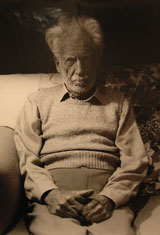The Men from Uncle
November 10 - December 5, 1998
(This statement is lifted, in brief, from the Introduction written by Margaret Dawson, to the book "the men from uncle", published by the Artist and Jonathan Smart Gallery, 1998, pp 11 - 13.)
In 1994 Uncle Hugh came to live at my place. Several months earlier he had fallen downstairs in the middle of the night and landed on his head. He suffered subdurral bleeding as a result of this heavy fall, and lost significant memory...
By working with Hugh on an art project I can make sense of him living with me and not in an "old boys" home, as he calls them. The ideas for this work came out of our closeness and activities together and his noticeable resemblance to several well known figures of authority...
In caring for Hugh I create his appearance. HIs clothes are put out in the order they are to go on. He is reminded to shave and cut his nails. I try to maintain his previous distinctive sense of style. For a while we grew his hair and beard longer to make him look like people I think he's been influenced by. I knew the writers, musicians, and artists he appreciated from looking at his books. As a photographic subject he is constructed as a system of signs within existing visual conventions.
The idea for appropriating from art historical photographs came from my previous use of historical paintings. Are "mimicry" and "stuttering" the only forms of articulation available to women? Does imitating the work of others imply stealing their ideas? In "the men from uncle" the significance of the art historical image's original meaning is refuted by the new subject, an old man. As a mistress of photography I'm up to a little subversion. Consider the countless young female nude studies by male "photographers" that still dominate many photographic magazines. In my work a rounded breast is translated into a shrivelled up nipple on a sagging male chest.
Studying historical images revealed a lot to me: connections with other photographs; viewpoint of the photographer; the subject's relationship to the photographer and how a different context can alter meaning in a photograph. The image changed dramatically by redoing it. There was a different context and a challenge to the notion of originality. The looseness of the reworked image is unlike the Romantic tradition of many of the photographs I chose (in which the artists generate the only meaning). The content in "the men from uncle", or the subjects Hugh plays (such as Tennyson or Ezra Pound) are from the romantic heroic tradition, but because there is an ambiguity within the images, the meaning or intention is not authoritative or fixed....
"The men from uncle" follows on from my previous work. As photographer, director, actor or model within the image I have been the key figure for the manufacture of each of my artworks. In the Maladies (1991), and Amusements (1993) series, images were based on well known paintings from art history. In these I also contested authorship, as well as the power of the camera over the subject. The role of the photographer and the truth of photographic representation are also relevant issues. ...
The person with dementia (can) become almost nonexistent through being unknown, silenced and depersonalised. Many images deal with this sense of emptiness. Identity is too often based on visual appearance. Notions of memory and stereotype are downplayed. For example, old men of a certain era had beards and hair of a certain length if they were scholars. If they were working class they would be depicted in a different way. In "the men from uncle" the surpise is that one subject reappears in the multiplicity of persona. The idea of imposing various qualities or personality traits onto another person is not new. However, the consistent marker of identity in these images is not "Hugh" but "old age".
Some of these photographs are of the abject. The abject is often associated with other taboos like menstruation, death, skin and bodily fluids. I would add old age signs, wrinkles, dribbles and scars. These "darker recesses of social life...the refuse" as Kristeva argues, are "like the corpse, (indicating) to me what I keep permanently at a distance in order to live". My intention was to show the dignity of a being who was generally perceived and diagnosed as flawed by his age, deafness and slight dementia. His demonstration of repeatedly acting frailties and death scenes camouflage his geriatric vulnerability. When he momentarily acts for the camera as a Haitian mental patient or a corpse he retains his sense of self by control with deliberate artifice. He is an actor.
Margaret Dawson. 1998.
Selected works
1. After Steichen of Rita Gabo
selenium toned silver gelatin print
2. After Cartier Bresson of Ezra Pound
selenium toned silver gelatin print
3. Looking for Golden Carp
back-lit colour transparency
4. Looking for Golden Carp 2
back-lit colour transparency


 In 1994 Uncle Hugh came to live at my place. Several months earlier he had fallen downstairs in the middle of the night and landed on his head. He suffered subdurral bleeding as a result of this heavy fall, and lost significant memory...
In 1994 Uncle Hugh came to live at my place. Several months earlier he had fallen downstairs in the middle of the night and landed on his head. He suffered subdurral bleeding as a result of this heavy fall, and lost significant memory...